The next-gen MacBook Pro with Retina Display Review
by Anand Lal Shimpi on June 23, 2012 4:14 AM EST- Posted in
- Mac
- Apple
- MacBook Pro
- Laptops
- Notebooks
Last year when I wrote about the new MacBook Airs I offered two forward looking paragraphs:
What happens from here on out is what's really interesting. Intel has already committed to moving the TDP of its mainstream parts from 35W - 45W down to 10 - 20W. Since the Air is the new mainstream Mac notebook, Apple has already made that move. The performance in this 10 - 20W segment is going to get much better over the next two years, particularly once Haswell arrives.
The Thunderbolt Display is the first sign of what's to come. Moving IO controllers and expansion into the display, and potentially even moving discrete GPUs out of the notebook are all in store for us. Apple is really ahead of the curve here, but it's easy to imagine a future where laptops become a lot more like the new Air and shift to a couple high bandwidth ports instead of numerous lower bandwidth connections.
Perhaps I was being too aggressive in the prediction of a couple of high bandwidth ports. After all, the next-generation MacBook Pro with Retina Display features four such IO ports (2 x Thunderbolt and 2 x USB 3.0). But you get my point. Gigabit Ethernet and Firewire 800 are both gone. The discrete GPU is still present but I suspect even its days are numbered, at least inside the chassis. The personal computer as we knew it for so long, is changing.
The personal computer is getting thinner, lighter, more integrated and more appliance-like. The movement is no longer confined to just Apple either. The traditional PC OEMs are following suit. Even Microsoft has finally entered the PC hardware business, something it threatened to do for years but hadn't until now. Distribution models will change, the lines between different form factors will continue to blur. What was once a mature industry is going through a significant transformation. It’s exciting but at the same time it makes me uneasy. When I first got into this industry everyone had stories of companies with great ideas that just didn’t make it. As we go through this revolution in computing I’m beginning to see, first hand, the very same.
Apple makes the bulk of its revenue from devices that don’t look like traditional personal computers. For the past couple of years I’ve been worried that it would wake up and decide the traditional Mac is a burden, and it should instead be in the business of strictly selling consumer devices. With its announcements two weeks ago in San Francisco, I can happily say that my fears haven’t come true. At least not yet.
It’s been a while since Apple did a really exciting MacBook Pro launch. Much to my surprise, even the move to Sandy Bridge, the first quad-core in a MacBook Pro, was done without even whispers of a press conference. Apple threw up the new products on its online store, shipped inventory to its retail outlets, updated the website and called it a day. Every iPhone and iPad announcement however was accompanied with much fanfare. The MacBook Pro seemed almost forgotten.
With its WWDC unveil however Apple took something that it had resigned to unexciting, dare I say uncool status, and made a huge deal about it. Two weeks ago Apple did the expected and offered relatively modest upgrades to all of its portable Macs, all while introducing something bold.
Apple calls it the MacBook Pro with Retina Display. You’ll see me refer to it as the next-gen MacBook Pro, Retina MacBook Pro, rMBP or some other permutation of these words.
After using it for the past two weeks I can honestly say it’s the best Mac Apple has ever built. And there’s a lot more to it than hardware.
Portability
If you were hoping for a 15-inch MacBook Air, that’s not what the rMBP is. Instead it is a far more portable 15-inch MacBook Pro. I have to admit I was a bit let down the first time I laid eyes on the next-gen MacBook Pro, it looks good but it doesn’t look all that different. The disappointment quickly faded as I actually picked up the machine and started carrying it around. It’s not ultra light, but man does it make the previous chassis feel dated.
While I never really liked lugging around the old MBP (and it always made me feel like the old fogey at tradeshows where everyone else had something 13-inches or smaller), carrying the rMBP is a pleasure by comparison. Pictures really don’t do it justice. The impressively thin display assembly or overall chassis thickness look neat in a photo but it’s not until you actually live with the rMBP that you can appreciate what Apple has done here. I carry around a 15-inch MacBook Pro because it’s my desktop, and as such it’s incredibly useful to have with me when I travel. For my personal usage model, the Retina MacBook Pro is perfect.
If your workload demands that you need the performance of a MacBook Pro and your lifestyle requires you to carry it around a lot, the reduction in thickness and weight alone will be worth the upgrade to the rMBP. If you spend most of your time stationary however, you’ll have to be sold on the display and internal characteristics alone. The bad news is if the design doesn’t get you, everything else will.

From left to right: 11-inch MacBook Air, 13-inch MacBook Air, 15-inch MacBook Pro, MacBook Pro with Retina Display
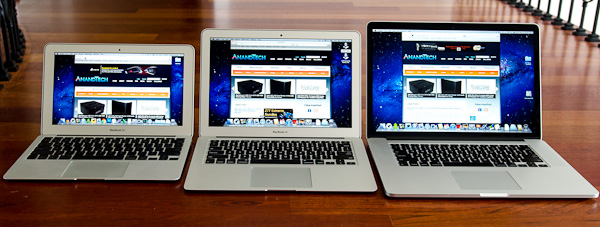
From left to right: 11-inch MacBook Air, 13-inch MacBook Air, MacBook Pro with Retina Display
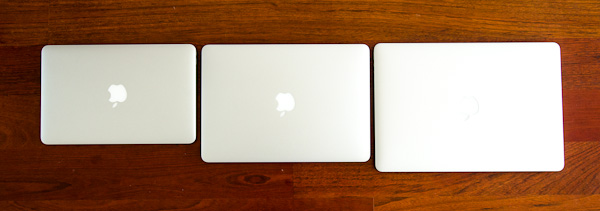
From left to right: 11-inch MacBook Air, 13-inch MacBook Air, MacBook Pro with Retina Display


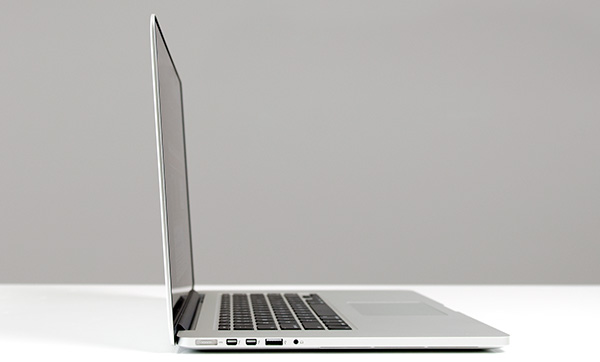
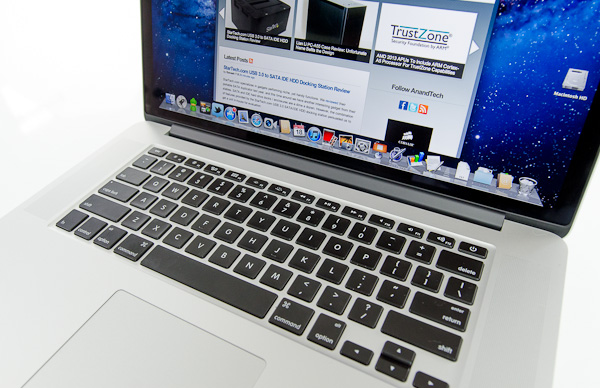
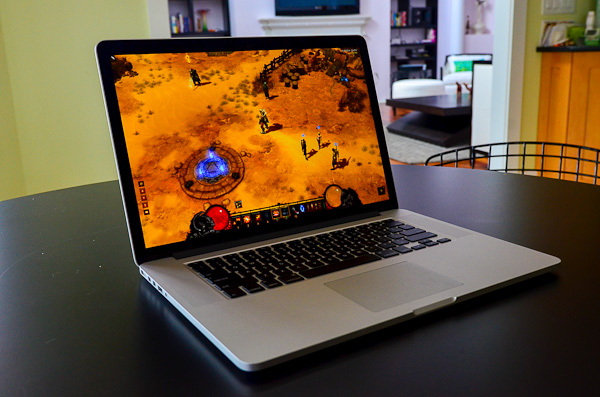
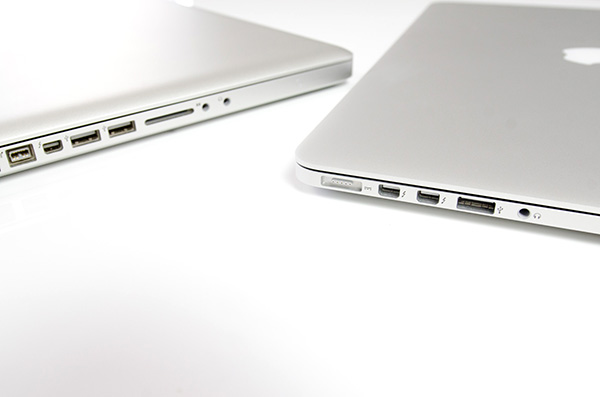
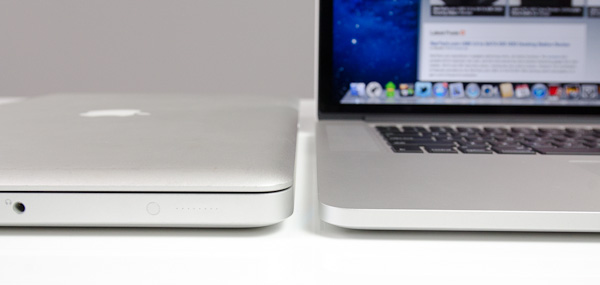








471 Comments
View All Comments
hyrule4927 - Saturday, June 23, 2012 - link
I appreciate your effort to add some numerical data to the review, but I still have to ask for a little more. You must admit that Half Life 2 is certainly not maxing out the CPU or GPU, and thus not a good representation of the maximum temperatures a consumer could see. I'd really like to see Furmark testing on the GPU and Prime95 or Intel Burn Test on the CPU, as these are some sure ways to keep the system at one hundred percent load. If you find these tests unreasonable, at the very least, try some more demanding game at a higher resolution. Or perhaps Folding@Home on a full 8 threads and the GPU client as well. If that doesn't push the CPU past 63C and the GPU past 72C, Apple has performed a miracle and created the perfect 24/7 folding system.Megatran - Saturday, June 23, 2012 - link
I agree, there needs to be a more comprehensive temperature test. The test for Half Life 2 may introduce bias into the results (if it was a CPU dependent game), as it would require less load on the cpu of ivy bridge thus resulting in lower temperatures. This creates a validity problem, as the temperature difference is not isolated to the difference in the design of the enclosure/cooling system.As in the above post, Prime95 for CPU and furmark for GPU and testing the maximum temperatures on both the 2011 mbp and the rMBP are good tests for comparison of temperature.
I am naturally skeptical of the temperature results of even your 2011 MBP test, as a few friends of mine have reported temperatures easily in excess of 85c+ while under full load. Whilst it is common for many people to believe it is "normal" for a CPU to be reaching that temperature and say it is "fine" if it doesn't shutdown, it would appear to have an effect on the lifetime of the said components under heat stress.
EnerJi - Saturday, June 23, 2012 - link
I'd love some more details on temperature as well. How does it behave with 50 Chrome tabs open, with Flash running in most of them, etc.wfolta - Sunday, June 24, 2012 - link
Non-scientific test: I started 8 UNIX "yes" commands, which pegged all 8 virtual cores, sending the CPU A power draw from 9.25 watts up to 13.75 watts. (It was plugged in and charging.) Not floating-point operations of course, and no GPU, but... After 4 minutes the CPU2 temperature was 207-210 degrees F, and the ENCLOSURE temperature was 93 degrees F. The fans were spinning at approximately 5000 RPM. I killed them off and approximately 30 seconds later, the CPU2 temperature was back down to 125 degrees F.The CPU A power was 13.75 watts during the test, and 9.25 afterwards.
Similar results with Cinebench.
EnerJi - Sunday, June 24, 2012 - link
Interesting, thanks for testing! When you say the enclosure temp was 93 degrees F, where / how were you measuring? Could you have rested the laptop on your lap for any period of time?Also, any comment on the lack of "buttery smoothness" with scrolling that Anand referenced? Is it very noticeable?
wfolta - Sunday, June 24, 2012 - link
By "ENCLOSURE" temp, I was literally just reading off of the iStat Menus 3 readings. It's a standard sensor somewhere.From what I've noticed, it's more comfortable on my lap than my 2010 MBP 17" has been. I was even able to play Diablo III with it on my lap, which I'd have never attempted with the old MBP.
The fans don't come on as often, and at lower speeds they're inaudible. Even at higher speeds, their white-noise quality makes them less annoying.
The scrolling has occasionally caught my eye, but I wouldn't say it's worse than the previous MBP either. More like a thing I noticed once or twice and brushed it off.
Some people have commented about the RAM. I've been running with 4 GB in my old MBP and it was adequate, but just barely. (Another factor was that my 7200 RPM hard drive failed and I had to replace it with a slower drive.) With 16 GB in the new machine, it means that I have two doublings, which Moore's-Law-wise means about 3 years before I'm back in the same boat. With SSDs, I'll actually be a bit better off. I'll take that.
If you can wait until next year's model, I hear that Intel's Haswell CPUs will be a noticeable improvement, SSD prices will have dropped significantly, as will retina displays.
EnerJi - Sunday, June 24, 2012 - link
Thanks for the subjective temp comments, and good advice.I have a late '08 MBP (bought in Spring '09 just before the refresh, and before I knew of the Mac refresh cycle!) and am itching to upgrade. I'm considering the base rMBP model with 8 GB RAM and 256GB Flash.
When I bought my current MBP 4 GB RAM was more than I needed, but I knew I'd grow into it. 4GB of RAM is starting to feel a bit limited right now (primarily because I keep too many Chrome tabs open), but when I start paging to disk I can usually solve it by closing a few tabs or (worst case) restarting my entire browser.
8GB RAM should be plenty for my needs, although again, it wouldn't entirely surprise me if in 3-4 years I start bumping into its limitations.
wfolta - Sunday, June 24, 2012 - link
To be honest, the machine I got was about 40% over my usual budget, but I also had a gift card that covered half of that, so I splurged. Without the gift card, I would've had to make a very difficult choice.Still, I'd lean in the direction of getting 16GB of RAM. You can use external drives and you'll be able to get a larger SSD down the road for a better price. But RAM is RAM and you can never really have too much. (At least for the things I do.)
hyrule4927 - Sunday, June 24, 2012 - link
So you managed to push the CPU to 99C? I am rather certain that the CPU will throttle at that temperature. So, it looks like this laptop can deal with single threaded games from 2005 with reasonable temperatures, but can't handle the heat when it has to do some real multithreaded processing. Hopefully a similar test will be added to the review soon.wfolta - Sunday, June 24, 2012 - link
You did't look at the graphs in the article, did you? They ran CInebench, pushing 8 threads to 100% for 20 minutes without any CPU throttling.